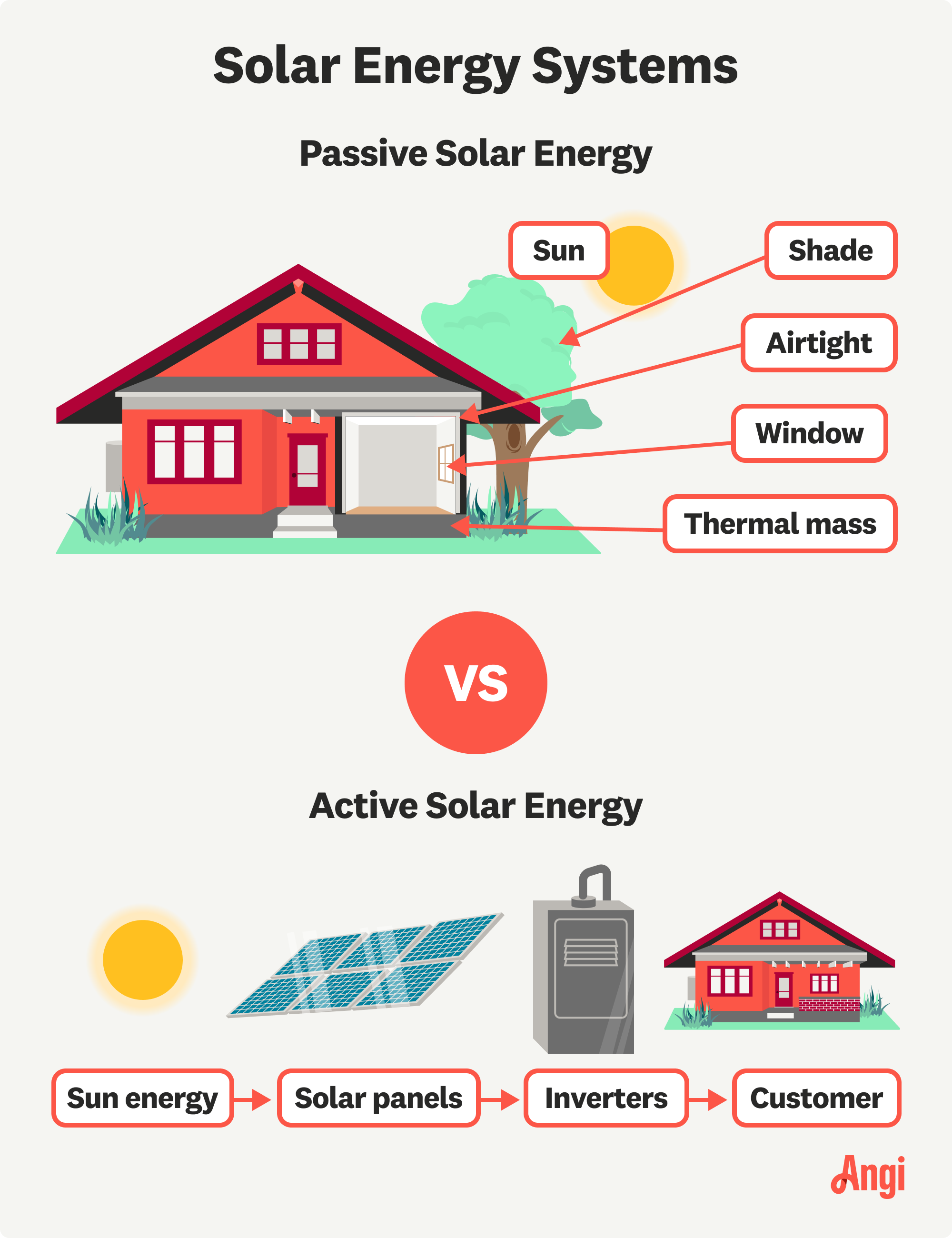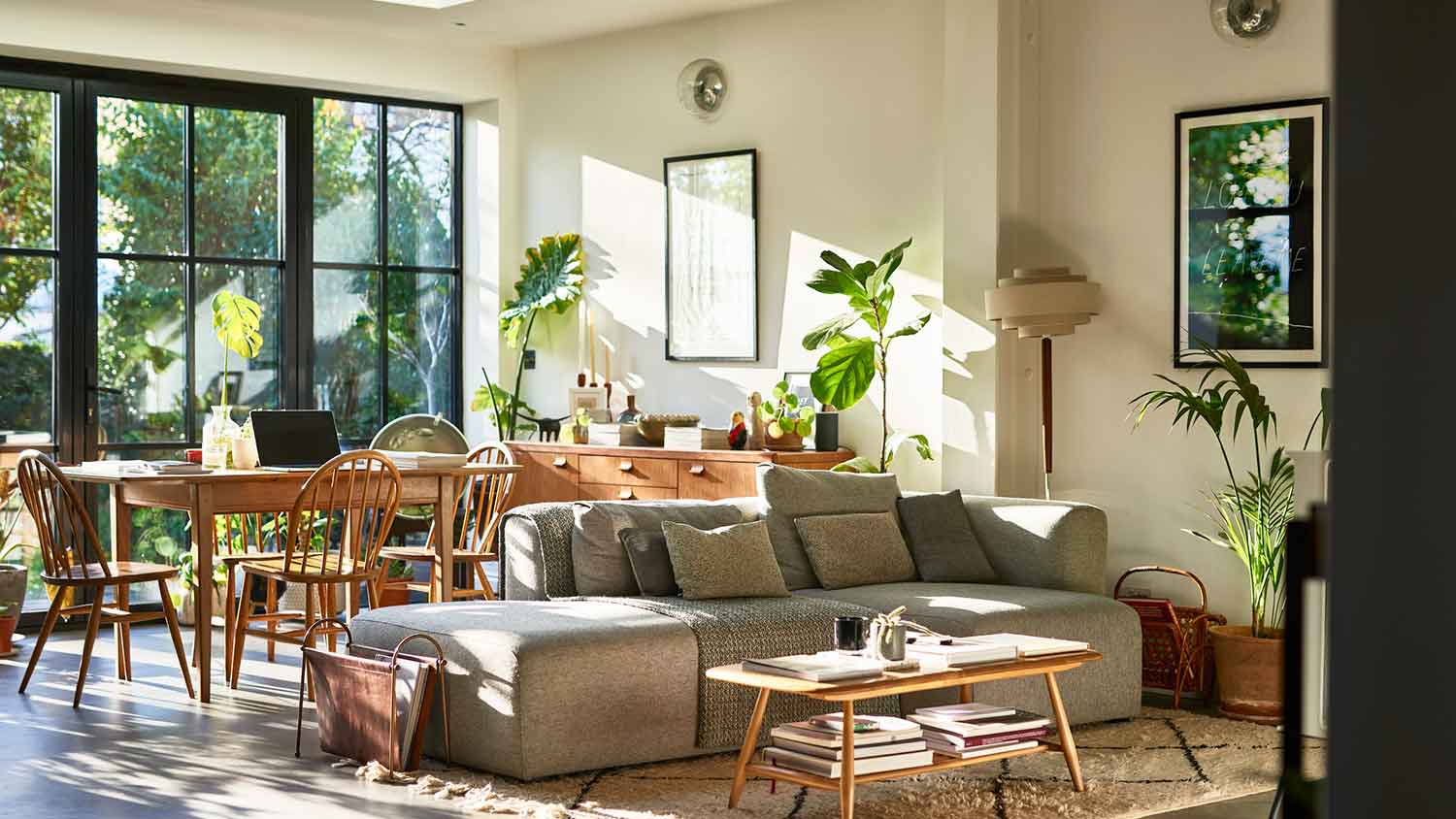
Discover the average solar panel inspection cost, what impacts pricing, and how to save. Get expert tips to keep your solar system efficient and safe.
The different ways to go solar


Passive solar systems implement home design and building choices to heat and cool homes with sunlight.
Like solar panel setups, active solar energy systems use solar technology to convert sunlight into usable energy.
Both options work best in sunny weather and can be combined for increased efficiency.
When looking into solar options, you’ve likely come across passive versus active solar energy. Whether you go with passive or active depends on the climate in your area and whether you need a solution for a new build or an existing home. Read on to discover all the similarities and differences, narrow down your choices, and better understand how solar energy works.
Passive solar energy refers to natural sunlight. Passive homes harness passive solar energy via specific choices with building materials, windows, shade, and ventilation to heat and cool the home. In comparison, active solar energy is captured with equipment that converts sunlight into electricity or heat and stores it.


Passive solar energy, or natural sunshine, might be something you don’t think much about beyond window placement when building a home. However, home designers and builders harness the sunshine with specific building choices.
For example, passive homes use materials with thermal mass, including concrete, stone, brick, and tile. When a material has thermal mass, it can absorb, store, and release heat. In the winter, these materials absorb heat from sunlight, which helps your home stay warm. In the summer, the thermal mass absorbs heat from the inside of the house to help it stay cool.
Additionally, windows are oriented toward true south and shaded during the cooler months. Thermal pane windows, like triple-paned windows, offer extra insulation.
Effective insulation helps prevent thermal bridging, which occurs when heat escapes the home through weak points. Passive homes are also airtight, meaning air barriers in the walls prevent air from leaking out.
Using passive solar energy doesn’t require special solar equipment and works best in areas with moderate weather and plenty of sunshine.
| Pros | Cons |
|---|---|
| Minimal maintenance | Requires sunshine |
| Zero ongoing costs | Potential for overheating or not enough heat |
| Natural solution for heating and cooling | Requires planning before breaking ground |
Best for:
Smaller homes
Homeowners in the planning stages of building a house
Supplementing other energy sources for heating and cooling
The best thing about using passive solar energy in your home is that it doesn’t need special maintenance. You’ll want to keep your south-facing windows clean and replace them as needed, trim the shrubbery and trees that provide shade, and maintain the thermal mass building materials like tile, concrete, and brick. Since all the costs of a passive solar energy system are paid for when you build the home, there are no ongoing costs.
Since harnessing passive solar energy means using natural sunlight, it’s as environmentally friendly as it gets. Even if your area only gets sunshine for a third of the time in the winter, like in the Pacific Northwest, a passive solar system can still be advantageous and help reduce energy consumption. In these scenarios, passive solar energy supplements other heating systems like heat pumps, electrical heat, and boilers.
The amount of sunshine you get annually is challenging to predict, depending on where you live. This can make the effectiveness of your passive solar system fluctuate monthly and year to year. You’ll also want to consider how much sunshine you get. In areas with a lot of sun, an improperly designed passive solar energy system can cause a home to overheat. Conversely, a house in an area with cold weather and not much sun may not get warm enough for comfort.
Unlike active solar energy, making the most of passive solar energy requires planning before breaking ground on your new home. If your home already has components of active solar energy, you can make some changes to an existing building. However, a passive solar energy system should be planned before construction starts.

Using active solar energy requires using equipment to capture sunlight for a home’s heating or electrical needs. Equipment includes solar panels and active solar heating systems. Solar panel systems work by absorbing sunlight and converting it into usable electricity. Solar heating systems use water (called hydronic collectors) or air collectors to capture sunshine through liquid or air and turn it into energy.
| Pros | Cons |
|---|---|
| Equipment can be installed on most buildings | Proper maintenance is required |
| More reliable than passive systems | Equipment takes up large amounts of space |
| Savings on energy | Requires sunshine |
Best for:
Adding solar to existing buildings
Those wanting to lower their energy bills
Areas with plenty of sunshine
Equipment for capturing active solar energy can be installed on most buildings, so it’s the go-to choice for anyone who wants to go solar. You can also tie it into the electrical grid to supplement your current energy or heating systems. While it still requires sunshine to work, these systems are more reliable and consistent than passive ones.
Additionally, the energy cost savings with solar panels can be quite significant. An average home can save over $1,500 annually on heating and cooling costs.
Active solar energy systems are costly to install. Keep maintenance costs in mind, with solar panel cleaning costing $10 to $20 per panel. These systems are also bulky and take up a lot of space, so not all homes are a good fit for solar.
You’ll need sunshine to produce active solar energy. On average, you should get the equivalent of four peak sun hours per day. A peak sun hour is when sunlight is most intense during the middle of the day.
Here are more factors to consider when choosing between passive and active solar energy.
Guests are unlikely to notice when a home is built with a passive solar energy system. But if you add active solar energy to your home, you’ll need to install bulky and potentially unsightly equipment.
Both passive and active solar energy offer options and customizations. Passive homes all use the same building principles, but you can choose between different materials and methods. Active solar offers different options, from solar panels to water or air collectors.
Since harnessing passive solar energy requires specific building choices, the result is a whole-home system that can last for the lifetime of your house. Of course, you must maintain your home and replace triple-paned windows periodically, but overall, the system is highly durable.
In comparison, active solar energy systems are less durable. While solar panels and heating systems are designed to last for decades, they won’t last as long as a well-built home. Additionally, extreme weather can damage these systems due to high winds, falling tree limbs, and hail.
The cost of your solar energy system depends on your needs. While many believe that active solar energy costs more than passive, this is not always the case. For example, solar panels cost an average of $27,200, while active solar water heaters cost $2,000 to $4,000.
On the other hand, building a home costs $150 per square foot, which is the starting cost of building a home with passive solar energy. However, depending on who you hire and the scope of your project, your home with a passive system can cost 10% to 30% more than a traditional build.
Both passive and active solar energy require professional installation. While an advanced DIYer can plan and install the necessary components of a passive home, it’s better to pass the job off to an experienced builder. There are several moving parts to juggle when planning a home, and hyper-focusing on passive solar energy could lead to big mistakes.
Likewise, the installation of equipment for active solar systems should be handled by pros. The electrical work required is complex, and the equipment is heavy and challenging to handle. Hiring a solar panel installer near you will help ensure a safe and correct installation.
Repairing active solar energy requires calling in a pro to troubleshoot. From wiring issues to equipment damage and failure, figuring out what went wrong can be tricky. On the other hand, fixing a passive solar energy system component is easier, like fixing a cracked window or repairing missing mortar on brick.
Passive solar systems don’t require specialized maintenance, while active ones do. You should clean solar panels two to four times a year, get a professional inspection annually, and keep a log of your energy production levels.
A well-planned passive solar energy system will last as long as your home. On the other hand, solar panels last 20 to 30 years, after which you’ll need to replace them with a new set.
From average costs to expert advice, get all the answers you need to get your job done.

Discover the average solar panel inspection cost, what impacts pricing, and how to save. Get expert tips to keep your solar system efficient and safe.

There are a few factors to consider when it comes to solar panel repair costs. This guide breaks down the prices of solar panel removal, repair, and replacement.

Discover the average solar panel installation cost, key price factors, and expert tips to help you budget for your solar project.

Are you planning to go solar? This guide will explain the different types of solar inverters and help you choose the best one for your home.

Avoid underpowered solar batteries and wasted money. From daily energy use to depth of discharge, this guide explains how to size a battery for solar panels.

There are three types of solar panels: monocrystalline, polycrystalline, and thin-film. Before choosing one for your home, here are the pros and cons of each.